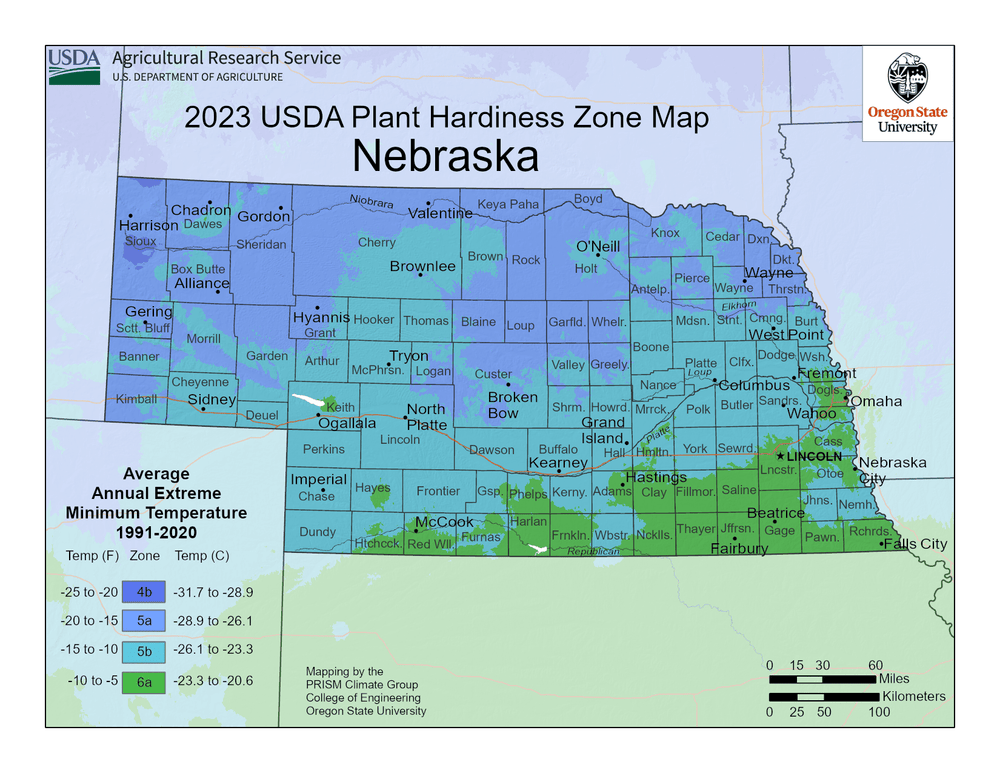Image from USDA
Characteristics of Nebraska’s Planting Region
Nebraska's climate is classified as continental, characterized by:
- Hot summers and cold winters with significant temperature swings
- Variable precipitation patterns, with more rainfall in the east than the west
- A moderate growing season, typically lasting from April through October
- Significant temperature fluctuations, with summer highs reaching 90°F (32.2°C) and winter lows dropping below 0°F (-17.8°C)
- Annual rainfall varying from 31 inches (787 mm) in the east to 13 inches (330 mm) in the west
As a Nebraska gardener, you may encounter:
- Extreme temperature variations between seasons
- Strong winds throughout the year
- Late spring and early fall frosts
- Periods of drought and occasional severe storms
Despite these challenges, Nebraska offers a reliable growing season. Most areas enjoy frost-free days from late April through early October, providing approximately 150-170 days for cultivation annually.

Challenges of Growing in Nebraska
1. Extreme Temperature Fluctuations
Nebraska's position in the continent's heart creates dramatic temperature swings that can stress or damage plants throughout the growing season. These fluctuations are particularly challenging during spring and fall transitions when a single day might see temperatures shift from near freezing to over 80°F (27°C).
2. Wind Exposure
Nebraska's persistent winds can physically damage plants and rapidly dry out soil, making it difficult to maintain consistent growing conditions. Strong winds also interfere with pollination, making it challenging to use protective coverings or season-extending materials in the garden.
3. Short Growing Season
Nebraska's growing season typically spans only 150 days, limiting options for long-season crops and requiring careful timing for planting and harvest. The compressed growing window means gardeners must be strategic about crop selection and succession planting to maximize their harvest before the first frost arrives.

The Benefits of Using a Greenhouse in Nebraska
While Nebraska's climate allows for productive seasonal gardening, a greenhouse can dramatically expand your growing possibilities.
1. Extend Your Growing Season
- Without a Greenhouse: Nebraska's outdoor growing season is limited by frost dates and extreme temperature fluctuations.
- With a Greenhouse: A greenhouse provides a controlled environment to start planting 4-6 weeks earlier in spring, extend fall growing by 4-8 weeks and protect plants from unexpected frost events.
Learn more about your area's specific growing dates and the best vegetables to plant in each part of Nebraska.

Customer images of their Greenhouse setup in Florida
2. Grow a Wider Variety of Vegetables Without a Greenhouse:
-
Without a Greenhouse:
Nebraska's outdoor gardens typically succeed with hardy crops adapted to the local climate:
|
|
-
With a Greenhouse:
A controlled environment allows for a wider variety of plants, including those that prefer cooler temperatures or a more moderate climate, such as:
|
|
|

Why Planta Greenhouses?
- Wind resistant up to 65 mph (learn more about how our greenhouses hold up in high-altitude climates).
- Withstands a snow load of up to 98 psf (480kg/square meter).
- Made with a heavy-duty galvanized steel frame.
- Polycarbonate panels provide 100% protection against UV rays.
- The Sungrow greenhouse is bell-shaped - allows the wind, snow, and hail to slide off the sides.
- Extendable (Sungrow, Sigma and Farmer models can be extended beyond 100ft)
- Made in Europe and are exclusively imported
- Maintenance-free

